Frequent Wind
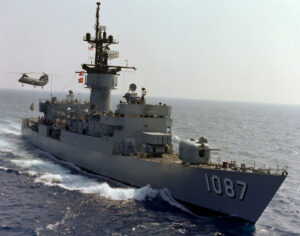
As of: 09/16/2007
Copyright © 2007 USS KIRK (DE/FF-1087) Association
Hunt. Kill. Two simple words that leave little to the imagination. In naval warfare they are the stark “bottom line” of antisubmarine warfare. The 46 destroyer escorts of the KNOX class entered the fleet in the late-1960s and early-1970s, heirs to the proud tradition of the deadly “Hunter-Killer” task groups of WW-II and the Cold War.
USS KIRK (DE-1087) was one of those ships. She was built to stalk, to pursue, to ensnare, and then to mercilessly pound her submarine prey down into the depths of the cold, dark sea. She was a warship in every sense, an efficient, utilitarian, deadly fighting machine. Yet some of her finest hours were spent tending pregnant women, soothing terrified little children, and saving the lives of tens of thousands. This is the incredible story of a brief episode in the early years of the long life of USS KIRK.
A CHANGE OF PLANS
KIRK sailed from San Diego in early March 1975, beginning her second Western Pacific deployment since commissioning in 1972. She was fully manned, fully trained, and loaded for bear. KIRK was as prepared for deployment as any warship could be. With her armament, machinery, and equipment fully operational, KIRK was “C-1 and M-1″ – 100 percent functioning and “mission ready”. KIRK was eager to pull her weight in the Seventh Fleet, but what began as a “normal” deployment soon changed dramatically.
War was still raging in Vietnam, but it was no longer KIRK’s war, as American combat forces were long gone. The war had been “Vietnamized” a few years previously, but now the news was dire. North Vietnamese forces were making swift progress as they pushed south, overrunning cities, towns, and villages, pummeling South Vietnamese forces seemingly at will. There was growing panic in the south. The long, costly Vietnam War was coming to a tragic end. One question remained: when would Saigon fall? Preparing for that inevitable outcome, American forces were gathering once again in the South China Sea and a complex operation was beginning to unfold: the evacuation of the remaining Americans from Cambodia and Vietnam, and the rescue of as many foreign nationals and loyal South Vietnamese as possible. Eventually, more than fifty ships of the United States Navy, plus a large number of Military Sealift Command (MSC) and civilian contract vessels took part in the operations, along with aviation units of the Navy, Marine Corps, and Air Force 1.
One facet of this intricate plan sent the venerable attack carrier USS HANCOCK (CV-19) to Hawaii to offload most of her air wing, trading in her Navy fighter and attack aircraft for Marine heavy lift troop carrying helicopters. HANCOCK then barreled at high speed from Pearl Harbor to the Western Pacific to join the growing evacuation group, receiving additional Marine helicopters along the way from USS MIDWAY (CV-43) in a late-night, high speed consolidation exercise in the San Bernardino Strait. KIRK was HANCOCK’s sole escort during that dash to the west. For KIRK’s bridge teams, line handlers and fueling teams, replenishing from HANCOCK at speeds in excess of 20 knots was an adrenaline-pumping break from the routine.
Cambodia fell before Vietnam, and KIRK played her part in “Operation Eagle Pull”, the early-April evacuation of Phnom Penh. It proved to be a quick, orderly extraction of fewer than 300 Americans – hardly a preview of the controlled chaos that awaited her later off the coast of Vietnam 2.
The Cambodia operation behind her, KIRK sailed south with USS COOK (DE-1083) and USS MIDWAY (CV-41) and steamed into Singapore on 16 April for a welcomed visit to that exotic port. But it ended all too soon when liberty was summarily cancelled, the crews abruptly recalled, and the three ships ordered to race back to the north to rejoin the evacuation force off the coast of Vietnam. Something was clearly brewing. During the preceding weeks the North Vietnamese noose had steadily strangled Saigon and Tan Son Nhut Airbase, and now there were virtually no remaining options. Encircled and cut off from the sea, Saigon stubbornly endured a few more days of ever-intensifying shelling by the oncoming NVA and Viet Cong forces 3. But finally, on the morning of 29 April, with Communist forces penetrating the city from all sides, there were no remaining options. It was time to go. American ambassador Graham Martin reluctantly ordered the long-anticipated pullout from Saigon, and “Operation Frequent Wind” was underway.
EXODUS BY AIR AND SEA
During the next two days over 7,000 “official” evacuees were flown from the courtyard of the American Embassy in Saigon, and the Defense Attache’s Office (DAO) compound at Tan Son Nhut Airbase on the outskirts of the city 4. The unmistakable sound of American heavy helicopters thundering in from the sea and across the city signaled to those below that the evacuation was in full swing. All morning long, KIRK patrolled her assigned defensive area off the coast at Vung Tau, near the mouth of the Saigon River, and witnessed the American helicopters cycling in from the sea and back out, delivering their human cargo to the ships beyond the horizon.
With word of the long-anticipated evacuation operation spreading rapidly throughout Saigon, numerous South Vietnamese Air Force (VNAF) helicopters independently took to the air and joined the exodus. Although not part of the formal Frequent Wind “flight plan”, these uncoordinated, impromptu helicopter evacuations grew into a mass escape from land to sea, and were directly responsible for saving thousands of lives. fig1 These ragtag remnants of the South Vietnamese Air Force were on their own, piloting small, grossly overloaded, shot-up, low-on-fuel utility helicopters, ferrying their terrified families and friends into the unknown. These desperate aircrews – flying the ubiquitous “Huey” (UH-1) helicopters – were never considered in the detailed planning of the Frequent Wind operation, and they soon proved to be a complication. Nearing fuel exhaustion, scores of these “unknown” contacts swarmed out to the large American ships on the horizon. The VNAF Hueys frequently disrupted the orderly landing patterns of the waiting aircraft carriers and amphibious ships, as they alighted by the dozens – uninvited – on crowded flight decks. Some, with empty fuel tanks, were forced to ditch in the sea alongside the American ships, with the tragic loss of an unknown number of Vietnamese men, women, and children 5. Intent on reaching the larger flight decks further out to sea, these VNAF pilots overflew the numerous smaller ships stationed in defensive positions close in to shore. USS KIRK – with her small, but open flight deck – was one of those small ships that watched in awe and frustration as the heavily loaded UH-1s flew overhead, out to sea to an uncertain fate.
THE FIRST OF MANY
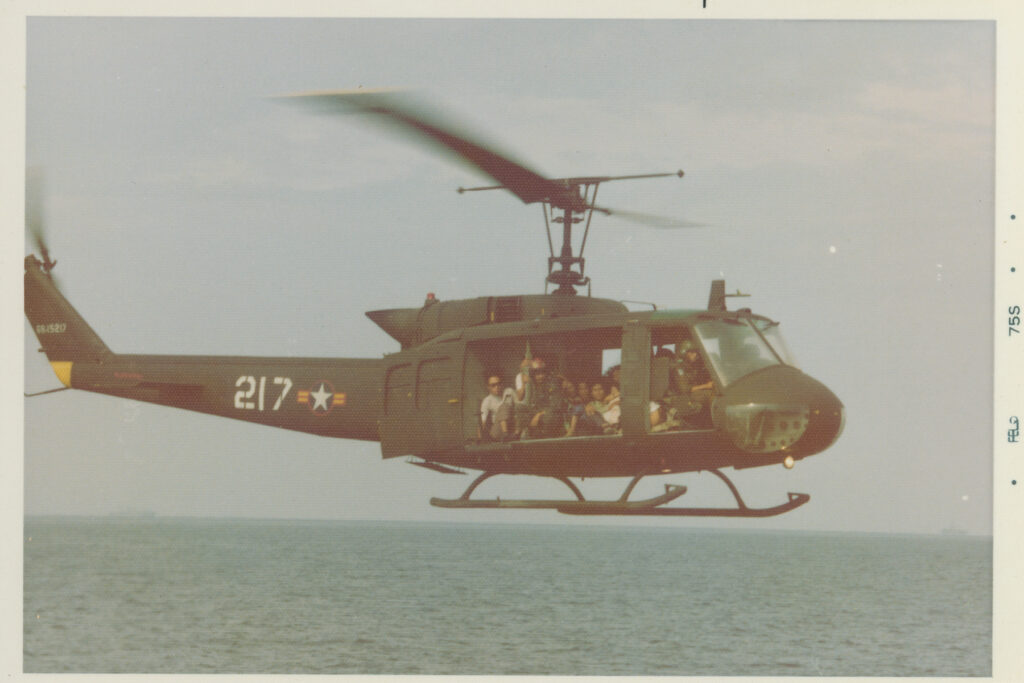
All morning long KIRK’s Combat Information Center (CIC) transmitted on the air distress frequency that “Ship 1087″ had an open flight deck. Under a broken overcast, with intermittent rain squalls, dozens of Hueys swarmed toward KIRK. But none of the Vietnamese pilots appeared to notice her, repeatedly flying close and low overhead the frigate, but further out to sea. Finally, shortly after noon, after hours of seemingly fruitless broadcasting, one of the VNAF pilots abruptly turned inbound to KIRK. It was a first for KIRK and a first for the Vietnamese pilot, but fortunately for both, KIRK’s young LSE (Landing Signal Enlisted) on the flight deck took it in perfect stride. The LSE – Airman Gerald McClelland – stationed himself in his usual place on deck beneath that unfamiliar helicopter, and guided the UH-1 safely in for its first landing on a rolling U.S. Navy flight deck. Over the next two days KIRK’s LSEs distinguished themselves time and again by safely landing sixteen Vietnamese helicopters without a single mishap, onto a flight deck designed to accommodate just one 6. fig2
Thinking that the first helicopter was a fluke and would be the only one to be taken aboard, KIRK’s flight deck crew dragged and pushed it to the forward port corner of the flight deck to be saved. But in rapid succession, more desperate VNAF helicopters began to circle KIRK. In short order, the second UH-1 was safely aboard (though the drooping rotor blades damaged the tail rotor of the stowed first Huey), and there were still more Vietnamese helicopters waiting their turn on “short final”. The flight deck was large enough to land just one helicopter, so each subsequent Huey had to be jettisoned over the side after the refugees were safely on board. fig3
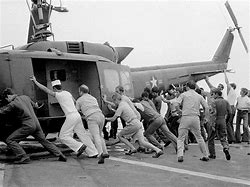
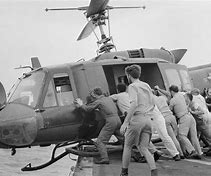
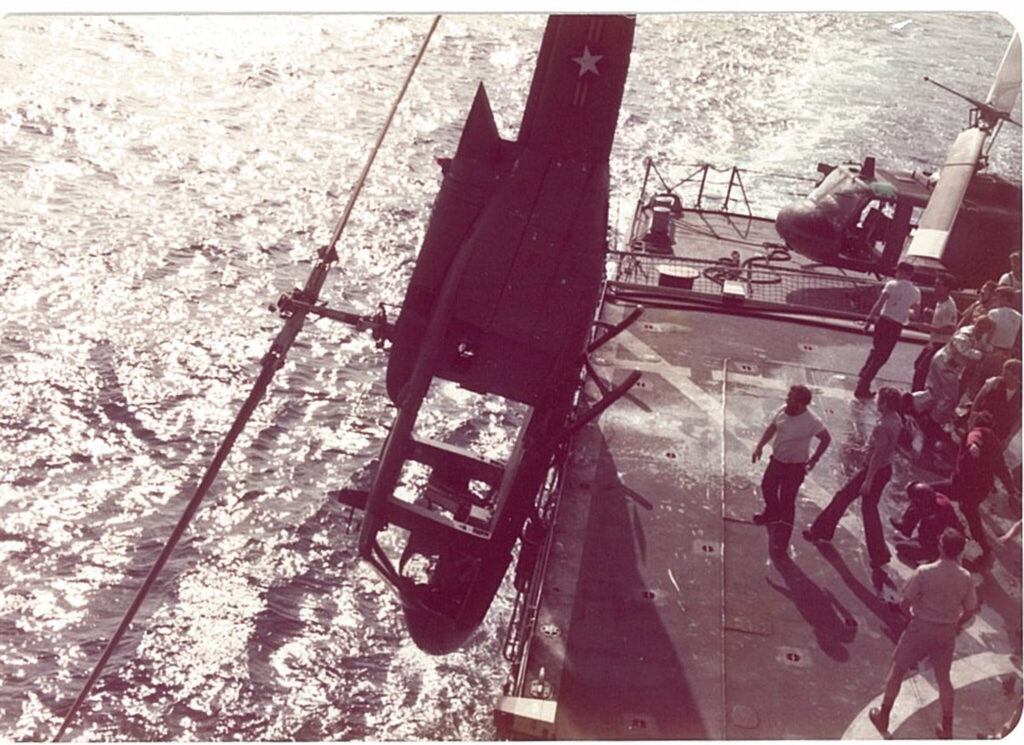
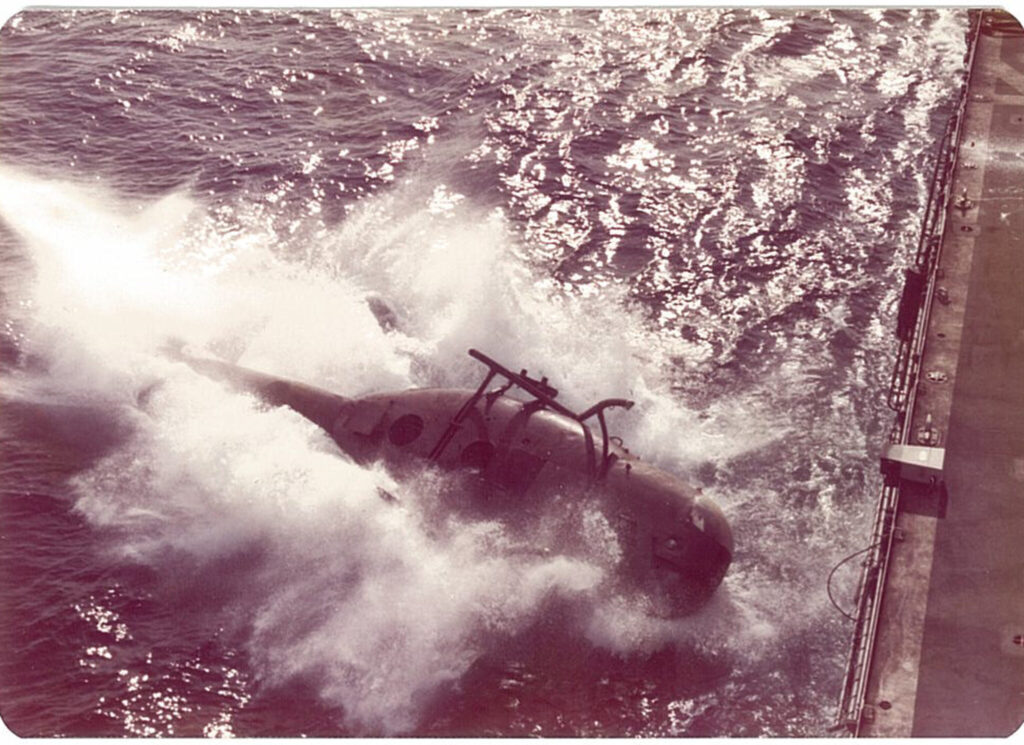
In this manner, by midnight on the first day, KIRK had recovered twelve UH-1s carrying a total of 157 refugees, more than half of whom were women, children, and babies. And by day three, that total had grown to sixteen UH-1s safely landed onboard, one CH-47 ditched alongside, and one USMC AH-1 Cobra gunship ditched nearby. During those three days, nearly 200 Vietnamese refugees and two U.S. Marine pilots found refuge in KIRK. And in the end, KIRK managed to find room on board to save three Vietnamese UH-1 helicopters that were eventually returned ashore at the U.S. Naval Station, Subic Bay, and one Air America UH-1 that was successfully transferred at sea to USS OKINAWA. fig4
Among all the Hueys on that first day, a crowded Vietnamese CH-47 (a twin-rotor “Chinook”, the heaviest helicopter in the Vietnamese inventory) also attempted to land but was frantically waved off.
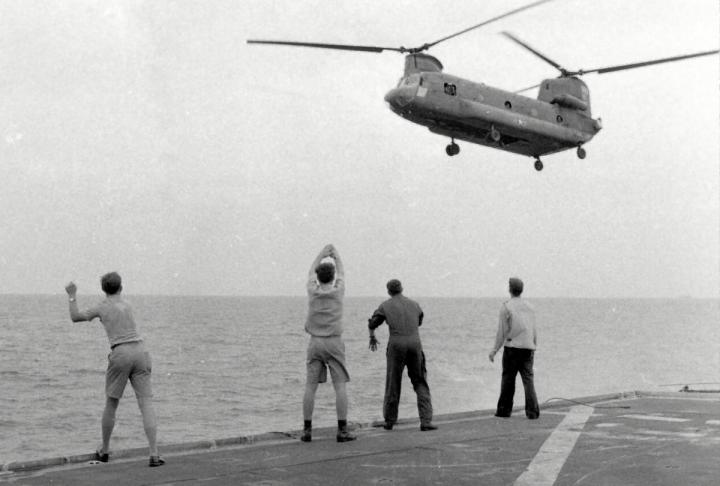
The aircraft was much too large for KIRK’s flight deck, so the pilot hovered low over the fantail and unloaded his precious cargo of men, women, children, and infants – and his aircrew – into the waiting arms of KIRK crewmen below 7. Then, flying his behemoth helicopter all alone, the pilot moved a short distance off KIRK’s starboard quarter, hovering within inches of the sea. He slowly rolled the Chinook on its right side, escaping the spectacular crash unharmed by diving out the left door in mid-roll.
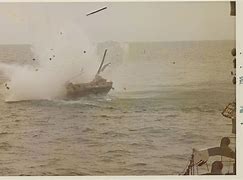
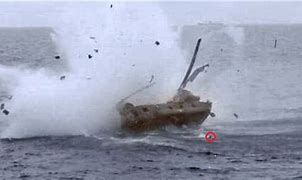
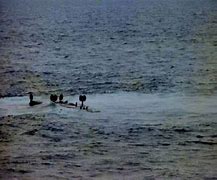
Both main rotors disintegrated on impact, and shattered shards of the blades flew across KIRK, splashing into the sea well to port. The crews of KIRK’s gig and motor whaleboat were standing by and rescued the pilot in short order. There could hardly have been a more masterful bit of flying, or a braver pilot that day. fig5 Ironically, the most complicated aspect of the rescue was the recovery of the half-dozen, or so KIRK crewmen who, on their own, jumped pell-mell into the sea in a well-intentioned, but vain attempt to save the passengers of the ditched Chinook – passengers who were in fact already safely on board KIRK. In a comic touch, the would-be rescuers ran right past the Vietnamese passengers, not noticing them in their single-minded mad dash over the side!
Cobra – The Last Helicopter Out of Saigon
Later that night, at the beginning of the midwatch, yet another helicopter was observed inbound to KIRK. This one, however, was a U. S. Marine Corps attack helicopter, an AH-1J Cobra gunship that had lingered until the end above the American Embassy compound, providing protection to the evacuation force. fig6 It was out of fuel and unable to reach USS OKINAWA (LPH-3) far out on the horizon. Making a one-shot attempt to set down on KIRK – the only lights visible for miles around – the pilot, Capt. John Bowman, USMC and his copilot/gunner, 1st Lt. David Androscot – saw that the flight deck was “fouled” (the last Huey to touch down on KIRK was still on deck) 8. With both engines flaming out, the Marine pilots had no choice but to wave off, turn away, and auto-rotate into the sea about a half-mile from KIRK. The touchdown – dimly illuminated by KIRK’s signal lights – was observed by many of KIRK’s crew, who witnessed a superb demonstration of airmanship under the most extreme conditions. The motor whaleboat crew – with rescue swimmer AWAN Mike Washington on board – quickly retrieved the Cobra crew, none the worse for wear. They were flown back to OKINAWA the following afternoon by KIRK’s LAMPS pilots, LT Rick Sautter and LTjg Scott Steele aboard the blue and silver Air America Huey – ironically, the same helicopter that fouled KIRK’s flight deck the night before, leaving Capt. Bowman no choice but to ditch his heavily armed aircraft. (Their grateful squadron mates on OKINAWA – the Marines of HMH-462 – ransomed their returning comrades with the princely sum of five gallons of strawberry ice cream!) fig7
The morning of the second day brought a heavy downpour as the 157 refugees rescued the previous day were transferred by boat to one of the large American freighters that had gathered in a holding area about twenty miles off the coast. It was an emotion-charged parting that deeply affected KIRK’s crew, but drew loud cheers and applause from the grateful refugees as their boat pulled away in the torrential rain. KIRK was once again “civilian-free” and ready for action. But not for long. fig8
Shortly, two more Vietnamese Hueys, laden with refugees and low on fuel, bore in on KIRK and landed on her flight deck, like the twelve others the day before. By now it was routine. But these refugees were quickly transferred to the larger ships nearby, and KIRK sped back to the coast to an almost-surreal sight: hundreds of boats of all sorts were swarming out from the beach, going as fast as their small engines would carry them. Many were precariously loaded to the gunwales with refugees. They gathered around each of the large American ships in the holding area, impatiently waiting their turn to offload their terrified refugees. fig9
The sky was now eerily empty. The evacuation continued unabated, but now it was primarily water-borne, and there was no longer a pressing need for KIRK’s well-worn flight deck 9. So KIRK reverted to her original role of force protection, patrolling her assigned sector. But the anticipated air attack on the evacuation force never materialized. (One brief threat, an unknown, fast moving, closing air contact, was eventually evaluated “friendly” – a U.S. Navy A-7 jet with malfunctioning electronics. But this was a milestone for KIRK – the first time in her short life to go to genuine battle stations – “General Quarters” spurred on by the ominous phrase “this is not a drill”.)
As the afternoon wore on, KIRK’s Captain, Commander Paul H. Jacobs decided to save another Huey – the last to land was still sitting on deck – rather than jettison it like most of the others. But this one would find its new home not on the flight deck, but below and aft on the cramped fantail of KIRK. It would be a tight fit – the designers of the DE-1052 class ships never anticipated landing a helicopter in that tiny space – but after careful calculations and measurements, all agreed it would work. (Fortunately, KIRK was one of the few ships of the class that did not have the bulky box of the “Basic Point Defense” missile launcher installed on the fantail, as most others had.) After confirming the clearances to the overhanging flight deck, KIRK’s LAMPS pilots strapped in, lifted off, and gingerly set the veteran Huey down on the fantail, where the aircraft remained until it was offloaded by crane days later in Subic Bay.
Final Rendezvous Of The Navy Of The Republic Of Vietnam
Late in the afternoon of the second day, KIRK received orders to rendezvous with USS BLUE RIDGE (LCC-19), flagship of the U.S. Seventh Fleet for a boat transfer of “an important person”. That VIP turned out to be Richard L. Armitage, emissary of the Department of Defense (and a future Deputy Secretary of State). He had been working in Vietnam for some time planning the extraction of as many South Vietnamese Navy ships as possible. It was KIRK’s new mission to deliver Mr. Armitage to the Vietnamese Navy CNO’s flagship (HQ-03) off Con Son Island, east of the southern tip of Vietnam, early the next morning.
At dawn on the first day of May, KIRK was greeted by the somber sight of the remnants of the Vietnamese Navy: scores of boats and ships of all sizes and descriptions, either anchored, drifting, or slowly steaming in the vicinity of Con Son Island. Some were empty and had been abandoned in the previous days, but thirty-two ships that were determined seaworthy for open-ocean transit were overloaded with refugees. fig11 Aboard those ships were more than thirty thousand Vietnamese men, women, and children, and the entire fleet was well within striking range of North Vietnamese MIGs that were suspected to be operating freely out of the captured Tan Son Nhut airfield. Mr. Armitage’s monumental task was to quickly move those vulnerable ships and their precious human cargo out of harm’s way and east to the Philippines. And KIRK was detailed to lend a hand. This challenging undertaking became part of “Operation New Life”, the massive movement of Vietnamese refugees to the Philippines, then on to Guam, and eventually on to the United States.
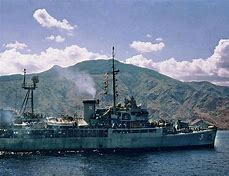
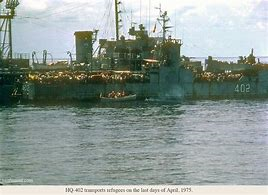
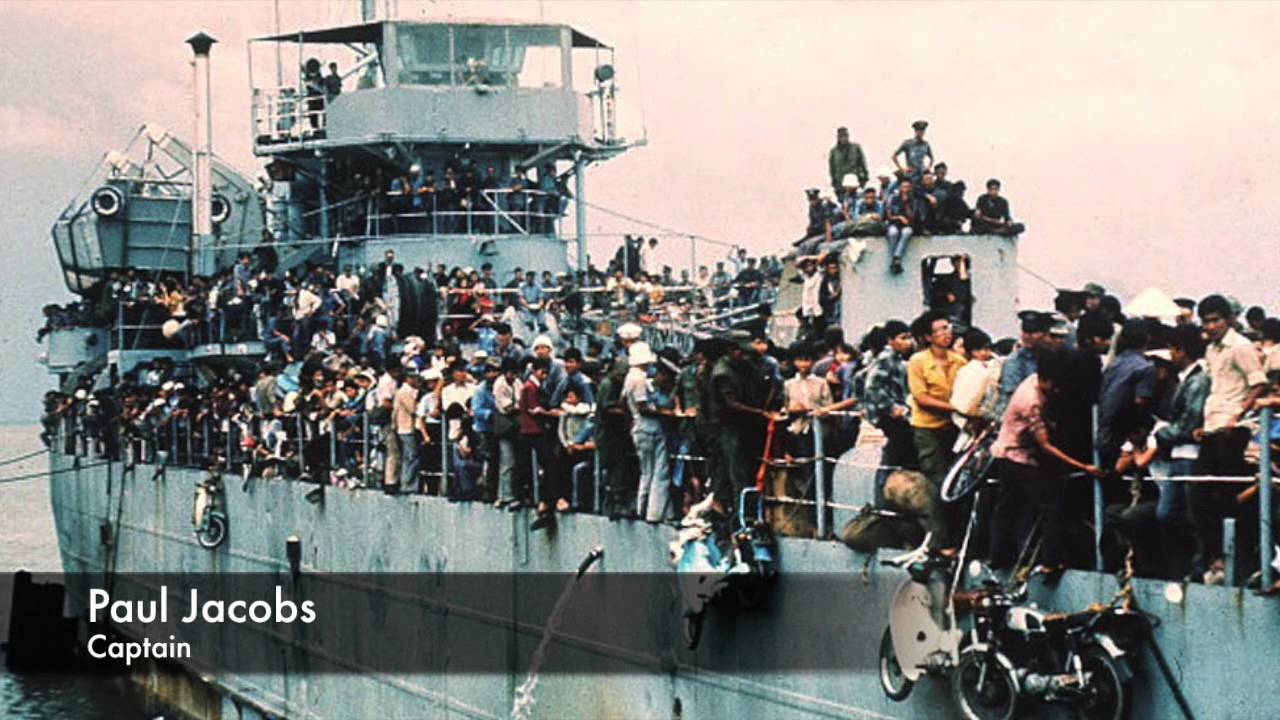
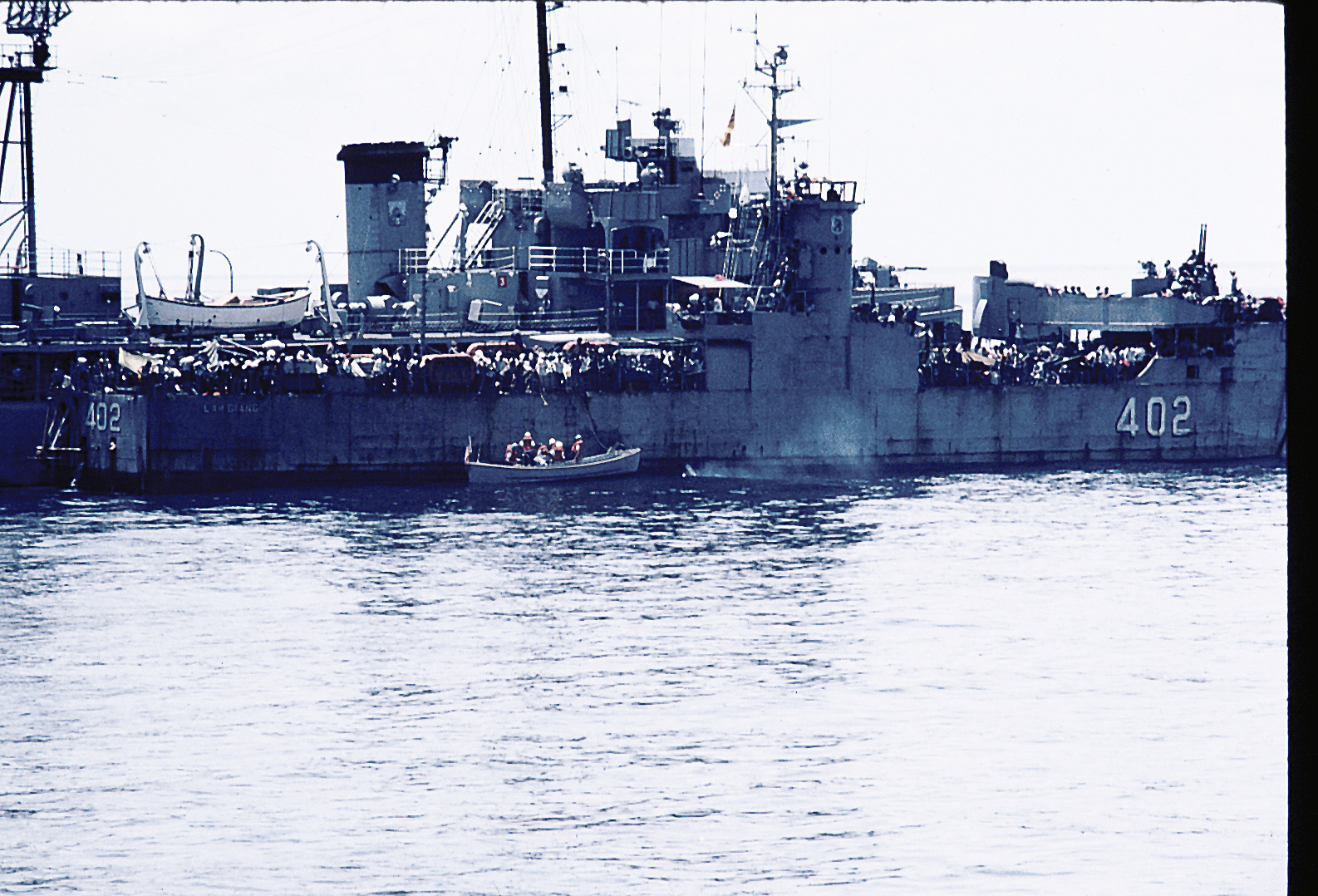
While Mr. Armitage worked to bring order to the milling Vietnamese ships, KIRK was busy picking up additional refugees from two civilian boats found drifting at sea, distributing food, water, and medical supplies to the anchored ships and gathering up a number of “unofficial” American citizens found among the Vietnamese refugees. A major undertaking was the assistance given to the Vietnamese ship RVNS LAM GIANG (HQ-402), an ex-USN LSM (Landing Ship, Medium). This small ship had barely escaped the previous afternoon from the dockyard in Saigon, with thousands of refugees aboard 10. It had been harassed by communist fire during its slow, harrowing escape to sea down the Saigon River. Limping along on just one engine and one failing electrical generator, its steering gear and bow doors damaged, HQ-402 was in immediate danger of sinking. With KIRK standing by with lifeboats, swimmers, and medical personnel, a larger Vietnamese ship was brought alongside the sinking HQ-402, and all the refugees transferred by jury-rigged planks to the larger ship. The severely damaged HQ-402 soon sank. KIRK then went alongside the larger Vietnamese ship to transfer water, food, and medical supplies for the terrified refugees 11. fig12
That afternoon, a VNAF pilot flew his UH-1 aboard KIRK from one of the Vietnamese LSTs in the formation, where it had landed days before. Aboard the Huey were four VNN SEALs (members of the Vietnamese SEa, Air, and Land special operations team) intent on ferreting out food and medications for the thousands of refugees aboard their LST. While the SEALs were below decks gathering their supplies, KIRK’s flight deck crew set about refueling the helicopter. Almost immediately, though, fuel began pouring from bullet holes in the Huey’s fuel tank. It had been so damaged by small arms fire that the fueling crew immediately jettisoned the helicopter over the side – as so many others had been “deep-sixed” just hours before. Unfortunately, neither the VNAF pilot nor the VNN SEALs were consulted in the decision to push the Huey over the side. When they returned to the flight deck, heavily laden with food and medical supplies and ready to fly back to the LST, the SEALs found to their chagrin that their helicopter was slowly sinking a half-mile astern in the wake of KIRK. The disgruntled Vietnamese pilot and his SEAL passengers returned to their LST by boat. That was Huey number fifteen. fig13
Later that same afternoon, KIRK’s LAMPS pilots were sent by boat to recover the sixteenth UH-1 from another VNN LST. It had been sitting on deck, open and full of fuel, in the midst of over three thousand refugees, an imminent hazard to the women and children huddled beneath it.
Clearing the area as much as possible, KIRK’s LAMPS pilots started the engine, gently lifted the Huey off the overcrowded LST to the applause of thousands of refugees, and flew the UH-1 back to KIRK, where it also remained until offloaded by crane in Subic Bay.
The First – And Last – Open Ocean Transit Of A Vietnamese Navy Fleet
Finally catching up to the formation again on 3 May, KIRK immediately went alongside the Vietnamese flagship, RVNS TRAN NHAT DUAT (HQ-03) to render engineering assistance in repairing her diesel generators, and in transferring 4,000 gallons of fresh water 13. KIRK’s crew was well used to going alongside another ship at sea, having refueled, rearmed, and reprovisioned numerous times. It was part of the routine for a warship at sea. But this time it was a full six-line moor alongside a drifting Vietnamese destroyer escort, not a highly choreographed underway replenishment. With Captain Jacobs t the conn, KIRK slid smoothly alongside HQ-03, and the line handling teams of both ships – Vietnamese sailors and American bluejackets – worked as one to snug the two ships together. fig16 KIRK and HQ-03 remained moored together for only a few hours, and when the last line slipped overboard on getting underway, some saw it as a larger, poignant symbol of the final parting of two old friends and allies.
Many hours later TAN NAM VIET, once again under her own power caught up with the formation, and KIRK’s exhausted – but successful – engineers, medical, communications, and supply personnel finally returned from both TAN NAM VIET and HQ-03. fig17
While alongside HQ-03, a Vietnamese sailor was brought aboard KIRK with a badly fractured leg. His injury required urgent transfer to a ship with a proper operating facility, but KIRK’s own helicopter – an SH-2F LAMPS – was “hard down” in the hangar. So while KIRK’s hospital corpsmen readied the patient for transfer, KIRK’s Air Department set about preparing one of the Vietnamese helicopters for one more mission. This helicopter was the very first to land, and had been pushed to the side of the flight deck. It was a virtually new aircraft and in excellent condition, except for the damaged tail rotor (clipped by the second Huey to land). In just a few hours, KIRK’s Air Department had it flying again with a transplanted tail assembly cannibalized from one of the UH-1s that was later jettisoned. With KIRK’s LAMPS pilots at the controls of this olive green “Phoenix”, the patient was successfully flown some distance to USS MOBILE (LKA-115) for treatment. fig18
Under the command of Commander, Destroyer Squadron 23 (Commodore Donald “Pete” Roane, embarked in KIRK), USS KIRK and USS COOK, USS TUSCALOOSA (LST-1187), USS DELIVER (ARS-23), USS ABNAKI (ATF-96), and USNS LIPAN (T-ATF-85) formed the immediate escort and support force for the remnants of the Vietnamese Navy. fig19 Other ships of the Seventh Fleet – including USS MOBILE (LKA-115), USS BARBOUR COUNTY (LST-1195), USS VEGA (AF-59), and USS DENVER (LPD-9) – though not part of the immediate escorting force, provided vital medical and logistical support throughout the remainder of the transit to Subic. The combined USN/VNN “fleet”, now nearly forty ships strong, then settled down to a slow, eastward transit toward the Philippines. The formation was a simple one: two parallel columns, each with sixteen refugee-laden Vietnamese ships stretching back over five miles, with the American ships maneuvering around and within the formation providing engineering, medical, and logistical support. fig20 Fortunately, the Pacific Ocean lived up to its name, as the transit was extraordinarily calm and peaceful. Few of the thirty thousand refugees had ever experienced the open ocean, but for the most part they were thankfully spared the misery of mal de mer. fig21

A New Generation of Americans
Assistance teams from the U.S. Navy ships conducted systematic daily visits to each refugee ship, tending to the many serious engineering problems of the Vietnamese ships, and also ministering to the health and nutritional needs of tens of thousands of refugees. A number of pregnant women were eventually discovered in the teeming crowds, and the decision was made to consolidate these at-risk women – along with their extended families – aboard KIRK, where a compartment was quickly converted into a makeshift maternity ward 14. Volunteers from KIRK’s crew were assigned to tend to the needs of these women and their families around the clock. These young sailors, such as Don Cox from the Air department, and Todd Thedell of the Operations Department, performed their unusual “non-military” duties in a truly outstanding fashion. Eventually, over a period of two days, a total of five expectant mothers – two nearing full term – were resettled aboard KIRK. The first of these young mothers-to-be was Nguyen Thi Tuong-Lan Tran who was brought on board on 3 May. Her husband, a pilot in the Vietnamese Air Force, had been left behind in Vietnam. Lan Tran was in the final month of her pregnancy, and had endured weeks of turmoil and privation prior to her escape aboard the Vietnamese ship RVNS LY THUONG KIET (HQ-16). She was in poor physical shape when she and her elderly mother were transferred to KIRK, but once aboard she improved markedly, and gave birth to a beautiful little girl three weeks later in the refugee camp in Guam. Lan Tran was so appreciative of the care provided by the crew of KIRK, that she formally named her little girl Tran-Nguyen KIRK Giang-Tien 15. fig22
By the following day, 4 May 1975, four more pregnant women had been located and transferred, with their families, to KIRK. One of the four, Nguyen Thi An, was also nearing full term, and had to endure two transfers at sea: first, from the ill-fated HQ-402, when she and her small family hastily abandoned that sinking ship across the makeshift planks, and then again when she was discovered in the crowd and transferred by small boat to KIRK. Nguyen Thi An also gave birth to a beautiful baby girl at the refugee camp in Guam three weeks later, naming her Rose Ann Vien Phuong Pham. fig23 As this article “goes to press”, another of the five then-pregnant women has been identified, and attempts are being made to contact her – and her child.
On that same day, 4 May, two seriously ill infants – one with pneumonia – were brought aboard; seven tons of rice were loaded by hand in twenty minutes through KIRK’s sonar access door in her stern; and throughout the day, medical supplies, food, and water were continually transferred by KIRK’s two small boats to Vietnamese ships in the formation. It was a routine day for more than thirty thousand refugees in the South China Sea. It was a routine day for KIRK. fig24
Even though the incidence of seasickness was relatively light (except in the “maternity ward”), the close, primitive, unsanitary conditions that prevailed in virtually all the refugee ships fostered widespread gastric problems, including dysentery and diarrhea. With so large a patient population, and the rapid depletion of the medical stores of the escorting American ships, large quantities of critical medications were flown out from Clark Air Force Base aboard a USAF EC-130. The Hercules skimmed low over the waves and airdropped sealed 55-gallon drums of medical supplies from its stern ramp into the sea alongside KIRK’s waiting motor whaleboat. fig25
Throughout the day on 5 May, a total of more than sixty U.S. Navy personnel were transferred in pairs to each Vietnamese ship to act as “liaison” personnel and to assist the Vietnamese crews in preparing their ships and refugees for entering port. fig26 These officers and men came from all the U.S. Navy ships in the formation, with KIRK supplying thirty-nine men on nineteen different VNN ships. They remained aboard their assigned ships until finally walking ashore in Subic Bay 16. fig27
Tuesday, 6 May was supposed to have been the day the refugee formation entered Subic Bay, and more than thirty thousand excited men, women, and children awoke to the day with great anticipation. But bureaucratic and political problems required the refugee fleet to delay entry into Philippine waters for a full day. This presented a serious dilemma to the fleet. Stopping nearly forty ships in mid-ocean for any length of time would bring chaos, and the thousands of refugees would surely misinterpret an abrupt “about face” so near to freedom. Were they heading back to Vietnam? Would their hopes now be dashed? Were they to be repatriated to their dreaded communist enemies? How could the senior officers in charge of this vast formation get reassuring word out in sufficient time to avoid massive unrest – even rioting – aboard these ships 17?
The solution was simple. Instead of a crisp, seamanlike “right standard rudder”, the formation instead gradually slowed and began an irregular series of small course changes that eventually covered many square miles of the Pacific Ocean. The meandering, slow motion turn took many hours to complete one full circle, and the frustrating delaying tactic was successfully accomplished without alarming a single refugee. But for the young sailors in KIRK, accustomed to the smart, agile maneuvering of their 35,000 horsepower destroyer escort, it was pure professional agony!
One condition of entry into Philippine waters was that all of the Vietnamese ships and all refugees aboard those ships had to be totally disarmed. This monumental task was accomplished throughout the rest of the day by small boats from all the American escorts, hour after hour, collecting literally thousands of small arms from all the Vietnamese ships. fig28 In the case of the ships themselves, all magazines and ready service lockers were stripped of their 20mm, 40mm, 81mm, 3-inch, and 5-inch ammunition, which was then jettisoned overboard, and all heavy guns and launchers installed in the ships were disassembled, and their operating mechanisms dropped over the side in deep water. It turned out to be a long, busy, grueling day for all hands, disposing of many tons of ammunition and ordnance under the watchful eyes of U.S. Navy personnel. fig29
With the morning of 7 May came word that the government of the Philippines had finally cleared the formation to enter Subic Bay, so at precisely 1200 noon, the crews of each Vietnamese ship fell in at formation to witness the solemn ceremony that passed command of their ship to the senior U.S. Navy liaison officer onboard 18. Striking the red and gold flag of the Republic of Vietnam, and raising the Stars and Stripes returned these thirty-two ships temporarily to the list of the United States Navy, a precondition for their entry into the territorial waters of the Republic of the Philippines. fig30 It was a difficult moment for the exhausted Vietnamese officers and men standing at attention in the brilliant sun. The Navy of the Republic of Vietnam was no more. fig31
Later that afternoon, those thirty-two proud ships, with the Stars and Stripes now snapping from their masts, sailed in precise formation into the deep protected harbor of Subic Bay. And thirty thousand brave Vietnamese people finally breathed free. fig32
Notes:
General Note: With few exceptions, this story is a first-hand account, told by the officers and men of USS KIRK (DE-1087), and some of the Vietnamese refugees rescued during Operation Frequent Wind. The structure and timeline of the account is based on three primary source documents dating from the Spring of 1975: 1) the USS KIRK (DE-1087) official “Ship’s Deck Logs” covering the months of April and May 1975; 2) the USS KIRK “Familygram”, a 16-page detailed chronology compiled in mid-May 1975, less than a week after the end of Operations Frequent Wind and New Life; and 3) the transcript of nearly two hours of voice recordings taped at intervals throughout the operation by a member of KIRK’s crew, describing the hour-by-hour events of KIRK’s participation in Operations Frequent Wind and New Life. These three “period” sources are augmented by many detailed personal memoirs of KIRK crewmen and former Vietnamese refugees, compiled thirty years later, as part of an ongoing project to write the history of USS KIRK (DE/FF-1087).
1. For an excellent detailed discussion of the immediate events leading to the fall of Saigon, see Chapter 5 of By Sea, Air, and Land: An Illustrated History of the U.S. Navy and the War in Southeast Asia by Edward J. Marolda ***(http://www.history.navy.mil/seairland/index.html), Department of the Navy — Naval Historical Center, Washington DC.
2. Walter J. Boyne, “The Fall of Saigon”, Air Force Magazine, April 2000.
3. Early in the evening of 28 April, KIRK’s Executive Officer, LCDR Dick McKenna was sitting at his desk penning the next day’s Plan of the Day – a plan that was shortly to be “overtaken by events”. He was interrupted when the Officer of the Deck (OOD) called down with an excited, “XO, you’ve got to come up and see this!” As McKenna recalls, “When I got to the bridge, the watch, plus a goodly number of the sailors that had come topside were watching the sky in awe.” He remembers it as “…the most memorable show of lightning that I have ever seen.” Others remember the same extraordinary display as the reflection of the intense artillery, rocket, and mortar barrage illuminating the cloud formations over the coast. Whether the awesome spectacle was a fluke of nature or simply the deadly work of man, all who witnessed it agreed it was, in LCDR McKenna’s words, “the most ominous and foreboding display”.
4. Walter J. Boyne, “The Fall of Saigon,” Air Force Magazine, April 2000.
5. In one memorable incident, a VNAF O-1 “Birddog” fixed-wing aircraft – the military version of a small single-engine Cessna – landed aboard USS MIDWAY, safely delivering the pilot, his wife, and five children in his first and only carrier landing. Fortunately, the fragile airplane was retained on board MIDWAY, and is now on prominent display at the Museum of Naval Aviation, in Pensacola, Florida.
6. Gary I. Cassat, LT, USN, “Impossible?” Fathom Magazine, Summer, 1976.
7. OS3 Peter Burinskas, MMFN Kent Chipman, and OSSN John Sullivan were three of the KIRK volunteers waiting in the rotor downwash on the fantail just below the hovering Chinook. All three caught falling infants and children, describing the sensation as “catching basketballs”.
8. Captain Bowman went on to a full career as a Marine pilot, retiring as a Lieutenant Colonel. Tragically, 1st Lt. Androscot lost his life in a training accident a few years after his heroic actions over Saigon.
9. KIRK’s normally robust flight deck – well-capable of handling helicopters equipped with wheeled landing gear – proved to be no match for the wheel-less landing skids of the many UH-1s. To reposition the Hueys or to move them to the edge of the flight deck for jettisoning, as many as twenty-five KIRK crewmen had to drag, bounce, and physically shove each three-ton helicopter across the non-skid deck, severely damaging the high-tech abrasive coating and deck-edge coaming.
10. Estimates of the number of refugees embarked – either total “fleet” figures or in individual ships – vary widely. As an example, eyewitness estimates from Vietnamese refugees aboard the ill-fated HQ-402 placed the total at “4,000″ or “5,000″. These figures for HQ-402 are clearly exaggerated, considering the small size of the ship – barely 200 feet long, less than half the length of KIRK – although “thousands” is probably a supportable rough estimate. Contemporary estimates – both official and unofficial – of the total number of refugees distributed throughout the 32 ships of the formation varied from 18,000 up to 35,000. Lower numbers were quoted officially at the time of the evacuation, presumably while the U.S. State department was negotiating with the Philippine government for permission to land the large numbers of now-stateless refugees. It is now accepted that the actual numbers were in excess of thirty thousand refugees distributed among the 32 ships. Considering the chaotic nature of the immediate evacuation effort, and the political sensitivities involved, such inaccuracies (unintentional or deliberate) were perhaps inevitable, but accurate census figures are probably available today in the archives that record the initial refugee settlement efforts on Grande Island, in Subic Bay.
11. The frantic scramble of thousands of panicking refugees from the sinking HQ-402 caused two disturbing deaths. A surge of Vietnamese quickly engulfed the rickety planks laid between the two ships. In the crush, a small child was pushed off a plank and fell to her death between the two ships. The panic of the crowd was quickly escalating to hysteria. Then in a jarring display of “justice swift and sure”, a Vietnamese sailor drew his pistol and shot the young man who had shoved the child overboard. Calm was restored, and the transfer of the refugees was completed in stunned silence.
12. TAN NAM VIET briefly captured the news a few weeks later when it was rumored that the otherwise unremarkable coastal freighter was carrying the bulk of the national treasury of South Vietnam. It was a time of many such rumors – few with any foundation.
13. Four thousand gallons of fresh water was about 40 percent of KIRK’s design total capacity, but after the hectic pace of activities in the previous days, potable water stores were ebbing, and 4,000 gallons was the bulk of the fresh water remaining aboard KIRK. But HQ-03 and her thousands of Vietnamese refugee men, women, and children clearly had a pressing need for all the water they could get. So fresh water hoses were run across to HQ-03. It was only after pumping 4,000 gallons of the precious liquid into the tanks of HQ-03 that KIRK’s engineers discovered that HQ-03 always had plenty of water, but her fresh water pump was out of commission. Something had been lost in translation, and this “failure to communicate” meant that KIRK went on “water hours” for an extended period to allow her excellent – but hard working – evaporators to catch up.
14. The rationale for consolidating these at-risk pregnant women aboard KIRK has been lost in the mist of time, but it turned out to be an extraordinarily good decision. Chief Hospital Corpsman Burwinkel was not only an independent duty corpsman, responsible for the health and welfare of more than 250 KIRK men, but he had coincidentally served a previous tour in the maternity ward of a large Naval Hospital. His pregnant charges were in good hands.
15. Lan Tran and her KIRK volunteer Don Cox have been reunited after more than thirty years, and have become fast friends.
16. The experiences of these men could fill volumes. Coming from the cleanliness, order, and predictability of a U.S. Navy warship, few of these KIRK men were prepared to witness the overcrowded squalor that these patient refugees were enduring. Following are the KIRK “shipriders” and their assigned Vietnamese ships:
Hull # Ship Name KIRK crew shipriders
HQ-01 Tran Hung Dao FTG3 W. S. Johnson and BTFA G. W. Malone
HQ-03 Tran Nhat Duat Mr. Richard L. Armitage
HQ-06 Tran Quoc Toan RMC L. Gassaway, ST1 T. A. Sievert, and ST1 D. R. Lucero
HQ-07 Dong Da II GMT1 T. J. Dixon and HT3 S. N. Hanenkrat
HQ-11 Chi Linh LT(jg) John S. Pine and BTFN R. J. Lalonde
HQ-12 Ngoc Hoi LT(jg) Scott J. Olin and SN G. E. Harrison
HQ-14 Van Kiep II LT(jg) Donald A. Swain and SA C. Richardson
HQ-16 Ly Thoung Kiet LT Frederick R. Sautter and ADJ2 R. G. Fisher
HQ-228 Doan Ngoc Tang GMGC H. M. Dilulo and TN3 F. L. Soderburg
HQ-229 Lu Phu Tho ADJC G. C. Bingham and STG3 E. W. Kirk
HQ-231 Nguyen Duc Bong SM1 H. W. Kenway and GMG3 J. R. Sanders
HQ-401 Han Giang LT(jg) Scott L. Steele and BTFN J. D. Scarrow
HQ-402 Lam Giang (Sunk)
HQ-404 Huong Giang ENS Bruce B. Davidson and OS2 T. D. Schultz
HQ-470 (unknown) IC2 T. A. Powell and EW2 P. E. Lawless
HQ-502 Thi Nai LT(jg) A. E. Porter and SA D. R. Carney
HQ-505 (unknown) LT L. E. Arcuri and ETR2 A. P. Gozdan
HQ-800 Huynh Van Cu ENS Robert A. Pennell and OS3 P. J. Burinskas
PGG-18 (unknown) EWC J. F. Willoughby and STG2 J. R. Wimbrow
Fishing Trawler #1 BTC J. D. Gornto and SA R. Bankston
Fishing Trawler #2 OSC D. T. Burlison and GMG3 G. N. Sanvig
17. Scattered among the thirty thousand refugees were a number of battery-operated short wave radios, tuned to the international news service of BBC. Consequently, many of the refugees were well aware that they were “stateless” people and that the Philippine government was apparently balking at their entry into Philippine waters. Wild rumors were beginning to spread that Philippine President Marcos would shortly recognize the new communist government in Saigon, quarantine the thirty thousand refugees aboard these thirty-two squalid ships for an indefinite period, and then deport all the refugees back to Vietnam to stand trial as collaborators of the Americans. Thus the delicacy of the decision to keep these thirty thousand exhausted refugees at sea for another 24 hours.
18. Because of another Philippine Government restriction, forbidding the entry of the remains of deceased refugees, KIRK was required to quickly arrange a burial at sea of a young woman who died while being transferred in a small boat to KIRK for medical treatment shortly before noon.
Watch the full episode of “The Lucky Few”
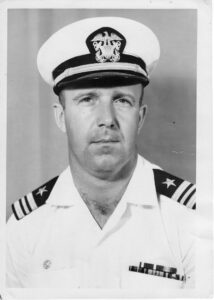
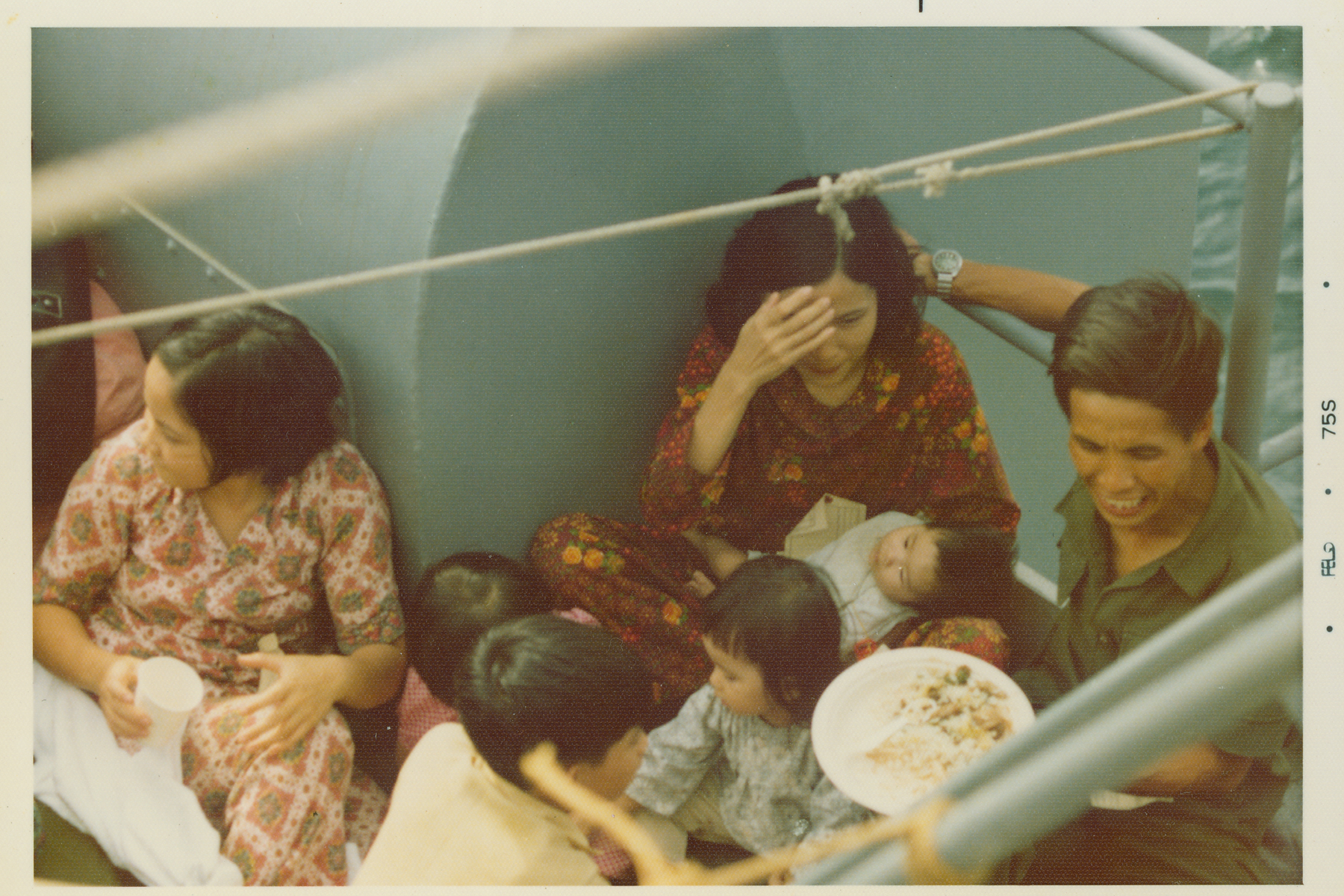
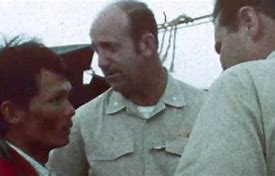
[…] As for the Kirk’s mission, however, there was a practical reason for the lack of publicity. Its success required that it be shrouded from public view. Led by the American Defense Attache’s office in Saigon, Kirk’s initial orders were to prevent the South Vietnamese navy from falling into the hands of the communist government whose armed forces had just taken control of Saigon. http://www.kirk1087.org/frequent-wind/ […]
[…] Frequent Wind – USS Kirk FF1087 Association […]
[…] War was still raging in Vietnam, but it was no longer KIRK’s war, as American combat forces were long gone. The war had been “Vietnamized” a few years previously, but now the news was dire. North Vietnamese forces were making swift progress as they pushed south, overrunning cities, towns, and villages, pummeling South Vietnamese forces seemingly at will. There was growing panic in the south. The long, costly Vietnam War was coming to a tragic end. One question remained: when would Saigon fall? Preparing for that inevitable outcome, American forces were gathering once again in the South China Sea and a complex operation was beginning to unfold: the evacuation of the remaining Americans from Cambodia and Vietnam, and the rescue of as many foreign nationals and loyal South Vietnamese as possible. Eventually, more than fifty ships of the United States Navy, plus a large number of Military Sealift Command (MSC) and civilian contract vessels took part in the operations, along with aviation units of the Navy, Marine Corps, and Air Force 1. […]
[…] Frequent Wind – USS Kirk FF-1087 […]
[…] As for the Kirk’s mission, however, there was a practical reason for the lack of publicity. Its success required that it be shrouded from public view. Led by the American Defense Attache’s office in Saigon, Kirk’s initial orders were to prevent the South Vietnamese navy from falling into the hands of the communist government whose armed forces had just taken control of Saigon. http://www.kirk1087.org/frequent-wind/ […]
Article in the Charlotte Observer Sept. 29, 2017
https://www.charlotteobserver.com/news/local/article175869441.html
Article in the Navy Times December 30 2018:
https://www.navytimes.com/news/your-navy/2018/12/29/remember-that-time-we-forgot-a-navy-and-had-to-go-back-and-get-it/
Hello, I am a vietnamese refugee that was drifted out in the sea for 3d/2n on April 29, 1975. I was 8 years old then. My grandparents, sister, aunt, and uncles were were able to espace the communist. We were on a raft that had sand bags piled up high. I remember that we were rescued by a navy ship but I don’t know if it were USS Kirk. Just reading and watching the untold story of The Lucky Few, I feel this was the ship that helped saved our lives. I never had a chance to express my gratitude for their service, compassion, and humanitarian heart. It would truly be an honor to meet the men that had saved us. Please email me if anyone know an upcoming event that my family can meet them. I really appreciate it very much. God bless America and the military men then and now. Please keep them safe.
Phuong,
Thank you for contacting us. Right now we have our next reunion scheduled for September in Colorado Springs, CO. Unless the COVID-19 stay in place orders are extended, we plan to still have the reunion. Please keep an eye out on our website for updates. Note the tab “2020 Reunion”. We look forward to meeting you.
I’m looking forward to attending the 2020 reunion. I served aboard the Kirk from May 1986 to November 1988. How many shipmates do you expect to be at 2020 event?
I have no idea Vincent. In normal years, most people wait until the last 30 days or less to make reservations. With everything going on, its just a guess at this point. I still plan to go ahead with it unless, by July the country isn’t back to near normal travel. Then I’ll likely cancel.
I was hoping to get more information, on nautical miles off the coast of Vietnam I was on the QUAPAW ATF 110 . and yes I was told that I wasn’t there, now they want me to prove I was with in the 12 nautical miles. Can anyone help me ?
I am former SMSN Curtis Hackney from the USS Kirk (FF1087). I have over 70 shipmates contact information. I would like to add you contact info. You can include you Name, email and phone numbers, and/or address. If interested, contact me at email: tectecman2@yahoo.com
I can also be reached by cell: 804.921.3865 (text or call).